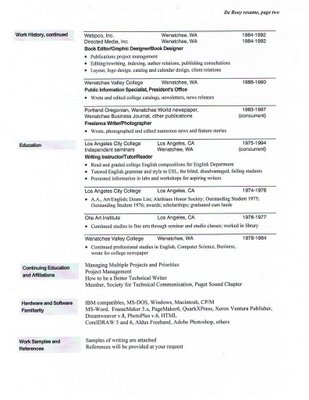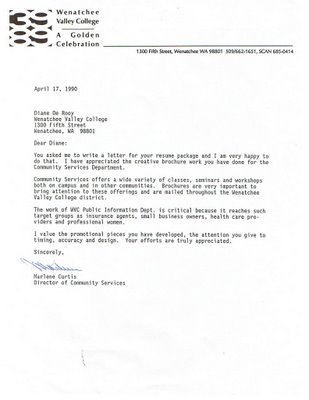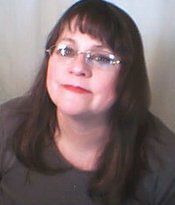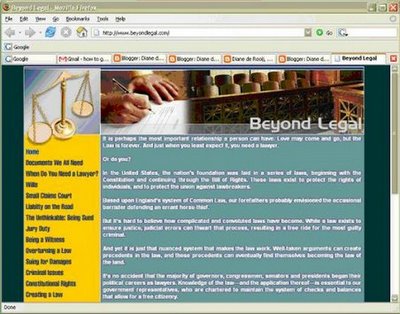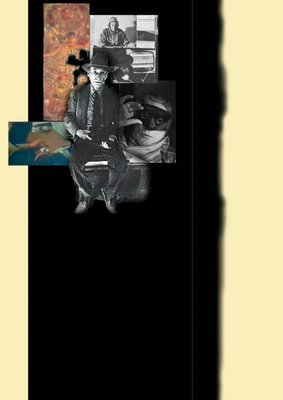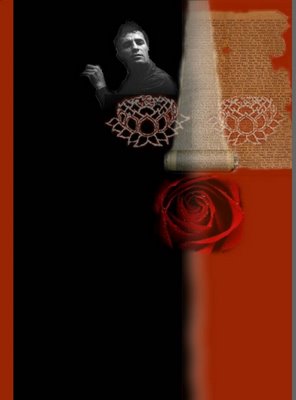Sunday, July 24, 2016
Wednesday, February 02, 2011
█ █ █ Writer for hire
I have many years of comprehensive, diverse writing experience. My work has ranged from NPR spot news to technical documents, from feature stories to website content.
Whether you need a team player or a self-starter, I am ready to meet your needs. I'm available for telecommuting to anywhere in the world.
Samples of my writing and my resumé are indexed here. Click on the links to your left to view them by subject or genre, or just scroll down.
If you find that my styles match your needs, please email me at dderooy at gmail dot com with your contact information. I'll respond to you within 24 hours.
Diane de Rooij
Tuesday, February 01, 2011
█ █ █ RESUMÉ
Monday, January 31, 2011
Sunday, July 30, 2006
█ █ █ RADIO
Saturday, July 29, 2006
Entiat Valley fire, 1994
But like all forest fires, no one had any idea how long it would burn and how much ground it would cover when it first started. They thought what happened to them was as bad as it would get.
ANNOUNCER
A fire in the Entiat Valley that's been raging out of control since yesterday has had effects ranging from disastrous to eerie. Diane De Rooy has the story.
DIANE
At shelters in Chelan, Leavenworth and Entiat, the Red Cross gave aid to nearly 100 fire evacuees. Public information officer Courteney SOOZ-mail and dozens of volunteers work tirelessly, even though they have trouble breathing in the stinging orange smoke.
SOOZ-mail tells stories of the fire.
On Wednesday, she noticed a couple working hard at the shelter, helping others to feel safe. Later, she discovered these volunteers were fire victims who had lost everything. They had no
insurance.
The humane society is sheltering frightened housepets until the fire is over. But not all animals fare so well.
One group of ranchers braved flames to reach their cattle on the fire line and herd them to safety. But as they approached they saw to their horror that the cattle who hadn't succumbed to smoke were on fire.
SOOZ-mail says the fire is literally creating its own weather system, with high winds that feed its fury.
There's still no sign of rain in the forecast.
For Northwest Public Radio, I'm Diane De Rooy.
ANNOUNCER
The Rat Creek fire south of Leavenworth cut a clean swath east to Blewett Pass, where it blazed through a group of homes before jumping the highway. Diane De Rooy has the story.
DIANE
Firefighter Dan Dittrich had barely returned from the Tyee Mountain inferno when he saw the Rat Creek fire heading for his backyard on Blewett Pass.
Dittrich dug fire lines and felled trees around the home he's building near the junction of Highways 97 and 2.
Then he headed for his neighbors' with bulldozer and backhoe, assuring them that everything would be okay if they made a stand, once he set backfires in motion.
Following Dittrich's lead, courageous residents stood their ground. All their homes were saved.
Diane Muranke and Kurt Neubert live on the other side of Highway 97. For eight years, they've been building a home, cutting and peeling each log by hand.
They were standing in their driveway when the fire jumped the road.
As they evacuated, Muranke looked back and saw that the ridge above their home was crowning with flames. In her heart, she wrote off eight years of work.
Muranke and Neubert returned to their land on Sunday to find their home still standing.
They know it's not over. Fire crews are using their road to get back in the woods and cut fire lines.
For Northwest Public Radio, I'm Diane De Rooy.
ANNOUNCER
Twenty-five miles from the center of hell, smoke and ash from the Entiat fire pour into the giant bowl of the Wenatchee Valley. Diane De Rooy has the story.
DIANE
Simple breathing is difficult. The oxygen has gone to feed the insatiable fire.
But most people around here are prepared. An 83-year-old devotee of yard sales didn't let the smoke stop her. She appeared at sale after sale, a wet hankerchief over her nose and mouth. As soon as she took the hankie away, she exploded into hacking coughs.
Yesterday, the Red Cross put out a call for nurse volunteers. They were swamped with calls, easily filling their quotas with plenty of nurses on standby.
In Entiat, one Red Cross volunteer says she can't tell day from night. She wonders if the fire will ever end.
Officials say this is the worst fire in two decades.
For Northwest Public Radio, I'm Diane De Rooy.
ANNOUNCER
Losses from fires in the Wenatchee Valley can be counted in dollars and cents. But one mountain woman, whose home was spared, counts her loss of habitat. Diane De Rooy has the story.
DIANE
You climb up a rustic road, then descend into a natural bowl made of old and new forest and a virgin meadow. There you see Pat Rasmussen's felt-covered Mongolian yurt, miraculously still standing.
Rasmussen, a world traveler, moved to the Witch Mountain area to live close to the forest and see how the animals interact. A phone line connects her to the EcoNet, where she can communicate with the whole world with her solar-powered laptop computer.
She had come to know her neighbors--a certain squirrel, a chipmunk, a salamander--who came to visit her every day. She didn't feed her animal friends, she says, because she didn't want to interfere with their natural process.
But since the Rat Creek fire, Rasumussen's habitat has been unnaturally altered by man. Her natural meadow was bulldozed down to the dirt to create a firebreak. Caterpillar tractors have etched a couple new roads in her land.
The fire was a painful experience, she says. Her land had been pretty much untouched, pristine and beautiful.
But it's not the burned part that bothers her. She always knew a lightning strike might come. If she hadn't had neighbors, her choice would have been to let the fire sweep across her land.
It's the fact that the fire was human-caused that has filled her with conflicting feelings, she says.
She has to get used to things looking different now. She's used to the green and the healthy.
But she knows fire is part of the forest system, a phase of the forest she is willing to live with and in. She went there to learn, she says.
As she surveys her land and the damage that was done, she sees her neighbors--squirrel, chipmunk and salamander. They're still there.
And so is she.
For Northwest Public Radio, I'm Diane De Rooy.
NPR: Murder Trial (Certification hearing)
Following six days of impassioned testimony to determine whether two 12-year-olds, charged with first-degree murder, should be tried as adults, Chelan County Superior Court Judge John Bridges made his decision. Diane De Rooy reports.
DIANE
For a week Judge Bridges was faced by two children, seated and shackled at the ankles, so small that their feet barely touched the floor of the courtroom.
The boys, John Duncan and Manuel Sanchez, told police they shot and killed farmworker Emilio Pruneda last summer.
Because the murder was brutal the state asked the court to try the boys as adults, allowing a minimum sentencing of 20 years in an adult corrections facility if convicted.
Bridges said the crime was probably the most serious he had ever seen come before his bench.
But he also determined both children came from extremely dysfunctional homes. They had not developed values that consider the rights of others, but only of their own survival.
Bridges said he doesn’t consider the boys to be victims. He said there were only two victims in this crime: Emilio Pruneda and the people of Wenatchee, who he says are not sure now that they can see a 12-year-old coming at them without wondering if he is armed.
Giving weight to the probability of rehabilitation Bridges ruled to retain boys in the juvenile court. Duncan and Sanchez will be arraigned tomorrow.
For Northwest Public Radio, I’m Diane De Rooy.
NPR: Murder Trial (arraignment)
In the decision not to try two Wenatchee 12-year-olds, charged with first—degree murder, as adults, the issue was rehabilitation versus retribution. Diane De Rooy reports.
DIANE
Last summer’s murder of farmworker Emilio Pruneda forced a hearing to decide if the juveniles should stand trial as adults. John Duncan and Manuel Sanchez are accused of shooting Pruneda to death, after hunting him down and surrounding him on the west bank of the Columbia River.
If the children had been tried as adults, they could have been sentenced to at least 20 years in adult correctional facilities. Teachers, therapists and juvenile justice workers pleaded for rehabilitation of the boys, rather than warehousing them in adult facilities.
Penny Hoiland, of Chelan County Juvenile, said simple incarceration would guarantee these children would never be rehabilitated.
Hoiland testified that the juvenile justice system would teach values, anger management and social skills, in addition to providing regular education and vocational training. Hoiland wants to see Duncan and Sanchez have a last chance to be children within the structure of the juvenile system.
She’s philosophical about the murder. She says Emilio Pruneda died to save these two children.
For Northwest Public Radio, I’m Diane De Rooy.
Thursday, July 27, 2006
NPR: Omak Stampede Suicide Race
40,000 spectators witnessed he 59th annual running of the Omak Stampede’s controversial suicide race. Diane De Rooy has the story.
DIANE
Twenty horses and riders charged over the edge of a bluff to plunge 250 feet down into the Okanogan River in a no-holds-barred contest considered barbaric by animal rights activists.
Cactus Jack Miller, with the Omak Stampede Association, calls the 1994 suicide runs “phenomenal.” He says most animal rights groups are misled as to how harmful this race is to horses.
No horses were killed but deaths of the past have brought PAWS'—the Progressive Animal Welfare Society’s—scrutiny to the race. Nine horses have been killed in the last 12 years.
PAWS didn’t hold a protest this year. It did attempt to stop the race by saying the horses block the river when crossing, violating a federal waterways law.
PAWS spokesman, Will Anderson, observed all four runs over the weekend. As riders come down the steep face of the bluff, they try to get in their opponents’ way, often causing massive pile-ups of horses and trampling of riders. Fights between riders are common, and participants are frequently taken away in ambulances.
Anderson says the audience is paying a $2 entry fee for the endangerment of human life and killing horses.
Miller defends the violence of the event, explaining that the same level of aggression exists in all sports. He likes to say it’s like sex; it’s wild and exciting and it’s over soon, and when you’re done all you want is more.
Anderson agrees the testosterone is out there, but it’s channeled into destruction and death. In a promotional video made for the suicide race, he cites 16 verbal allusions to pain and death, as well as 19 visual images of falling horses and injured riders.
While the Omak Stampede has the blessing of the National Rodeo Association, the suicide race is not sanctioned.
Anderson predicts several more horse deaths in future suicide races and says a human fatality is inevitable.
For Northwest Public Radio, I’m Diane De Rooy.
Wednesday, July 26, 2006
NPR: Billboards on Highway 2
ANNOUNCER
Following more than a year of developing a sign ordinance to control billboards in Wenatchee, an outdoor sign company is asking Chelan County to allow billboards along the Stevens Pass Highway. Diane De Rooy reports.
DIANE
The Obie Outdoor Advertising Company of Medford, Oregon has asked Chelan County’s Planning Commission to allow billboards along State Highway 2
Wenatchee resident Jim Snyder, who led the movement to revise the city’s sign ordinance, says the permits should be denied. He says the proposed billboards violate the spirit of the 30-year-old Scenic Vistas Act. At the time it was written, he says, the act was not comprehensive enough to incorporate the scenic rural highways of Washington State
The county planning department has recommended approval of one of Obie’s requested sites. It is directly on a Colville Indian burial ground near the city of Cashmere. If the permit is granted, Obie will have to obtain a letter from the Colvilles approving the billboard’s placement
The Chelan County Board of Adjustment will consider the request during its meeting tonight
For Northwest Public Radio, I’m Diane De Rooy
Tuesday, July 25, 2006
NPR: Skateboarders vs. downtown merchants
ANNOUNCER
The city of Wenatchee banned skateboarding downtown last year. Now taking a cue from cities like Moses Lake and Yakima, a park board member is determined to build a skate park for the displaced teen skaters. Diane De Rooy has the story.
DIANE
Wenatchee Park Board member Gene Anderson has formed a committee to research skate park funding and locations.
Skaters were banned after downtown merchants complained of extensive property damage and one businessman was run down by a skater.
After considerable debate, the city gave skaters some old tennis courts, saying the kids would have to make repairs and renovations at their own expense.
Skaters held car washes and bake sales, but only managed to raise $5,000 of the $25,000 they needed.
That was a year ago.
Anderson says adults have no credibility with youth if they don’t even attempt to make something happen. Inspired by the fact that the skaters raised $5,000 with no support, he has pledged to meet with his committee twice a week, if necessary, so he can approach the city commission with a complete skate park proposal.
For Northwest Public Radio, I’m Diane De Rooy.
Announcer
The Wenatchee Park Board skate park group will meet for the first time Wednesday at 5:30 p.m.
Monday, July 24, 2006
NPR: 12th District representation
ANNOUNCER
George Sellars, Dale Foreman and Clyde Ballard, all representing the 12th District, will lead the Republicans in the next session. Diane De Rooy tells us who these lawmakers are
DIANE
Six-term Senator George Sellars of East Wenatchee is highly regarded by Democrats and Republicans alike. The current minority leader of the senate is characterized as sincere, cooperative and fair.
Representative Dale Foreman of Wenatchee is also admired in his district. Foreman, a fiscal conservative, is able to take a moderate stance on people issues such as health care reform and taxes. A Harvard—educated lawyer, he is a steadfast defender of the constitution, as well as the healthy separation of church and state.
Only Clyde Ballard of East Wenatchee, the heir-apparent house speaker, draws criticism from both parties in his district. Friend and foe alike characterize his style as deliberately uncooperative. Opponents point out that Ballard took money from real estate lobbyists and then voted against the Growth Management Act.
Ballard says he accepts donations from people, but that he always votes the way he thinks is right, even if that means he shoots down the hopes of the lobbies that support him.
For Northwest Public Radio, I’m Diane De Rooy.
Sunday, July 23, 2006
NPR: 12th District Caucus
State Republicans are meeting in caucus Friday in Yakima to determine leadership in the house and senate. As Diane De Rooy reports, the front-runners in Republican leadership all happen to be from central Washington.
DIANE
Representative Clyde Ballard of East Wenatchee will be the new speaker of the house. Wenatchee representative Dale Foreman will assume the position of house majority leader. And state senator George Sellars of East Wenatchee hopes to stay on as minority leader. But he’s being challenged by Bellevue’s Dan McDonald. The race is said to be a tight one.
12th District constituents, no matter what their party affiliation, are eager to see what this leadership slate will mean for central Washington.
According to Sellars and Foreman, health care will be high on their agendas, followed by tax reform issues that affect property owners and businesspeople.
Ballard believes government should only do for people what people cannot do for themselves. That’s why he opposed the Growth Management Act and will fight to revise it in his seventh term in the house.
All three legislators agree that the 12th District’s needs have been overlooked by the western Washington democrats who once dominated the state legislature.
For Northwest Public Radio, I’m Diane De Rooy.
Saturday, July 22, 2006
NPR: managed health care
As health care reform sweeps the nation, medical facilities are accepting the idea that managed care will be in their future. But the competition that comes with change is hard for others to accept. From Wenatchee, Diane De Rooy has the story.
DIANE
A year ago, the Wenatchee Valley Clinic saw the handwriting on the wall, and the message was: managed health care is coming. Since day surgery is a large part of managed health care, the clinic began negotiating with Central Washington Hospital for use of its facilities.
But according to Dr. Chris Stahler, clinic board chairman, hospitals have very high built-in costs, prohibitive to the basics of managed care. Central Washington Hospital preferred not to negotiate on prices, he says.
The clinic felt compelled to construct its own facility, adjacent to its own doctors’ offices, to keep surgical costs down. The hospital saw that it could lose a great deal of market share, since clinic doctors perform more than half of the day surgeries now using hospital facilities.
Stahler sees more opportunity for cooperation between the two entities. The Rockwood Clinic in Spokane uses a surgery facility built for and leased to them by Sacred Heart Hospital, he says.
But negotiations between the hospital and clinic broke down repeatedly. Bulldozers are now busily taking up the asphalt where they are breaking ground for the clinic’s new day surgery facility.
Wednesday, July 19, 2006
NPR: Growth Management Act protest
What works in New Mexico won’t work in Washington. That argument is at the core of citizen protest in Chelan County against the so—called “Catron County” ordinance county commissioners want to adopt. Diane De Rooy reports.
DIANE
Some 500 counties throughout the West, including Chelan County, are considering a county ordinance based on the law in Catron County, New Mexico.
Similar legislation has already been overturned on legal challenges in Walla Walla and in Boundary County, Idaho. And even though Washington attorney general Christine Gregoire and Chelan County Prosecutor Gary Riesen have already issued statements advising against adopting the ordinance, Chelan County commissioners are moving swiftly ahead to approve it.
The Catron County ordinance model attempts to take powers away from state and federal agencies. Opponents point out that the areas affected include the Federal Clean Water Act, the Shorelines Management Act, and the state’s own Growth Management Act. In courts in Bonner’s Ferry, Idaho, and Walla Walla, Washington, these efforts to circumvent state constitutions have been found illegal.
Chelan County commissioners have already missed several deadlines for complying with the state’s Growth Management Act. Opponents see this proposed legislation as an attempt to further avoid filing a comprehensive plan.
Commissioners have called a public hearing to be held Tuesday, September 27th for citizen input regarding this proposed law. Opponents plan to marshal their resources for a public protest at that time.
For Northwest Public Radio, I’m Diane De Rooy.
NPR: Growth Management Act, public power
A Catron County-style ordinance in Chelan County could have negative effects on the ecology of the five valleys within. Yet there is serious support for such an ordinance. Diane De Rooy explains why.
DIANE
Most supporters of the proposed Chelan County “Wise Use” ordinance are senior citizens. They are farmers, hunters, landowners and pioneers.
Curt Epperson, an attorney from Manson, claims the feds have declared war on Chelan County. Epperson has assembled an extensive clipping file of outrageous government boondoggles. He uses these examples to show that the government is corrupt and must be replaced by right thinkers.
Perhaps most inflammatory to old farmers and grangers in Chelan County has been the recent argument between hydroelectric projects and free salmon runs. Interior Secretary Bruce Babbitt has stated that there are too many dams, and that he’d like to tear one of the big ones out.
Them’s fighting words in Chelan County, where the Grange Movement of the 1930s brought public power to the state and progress to farming.
Even though the Wise Use ordinance cannot succeed as written, it is the only weapon supporters feel they have right now to fight a government they believe is out of control.
For Northwest Public Radio, I’m Diane De Rooy.
NPR: Growth Management Act, housing
One phase of the state’s comprehensive Growth Management Act requires that local governments provide for adequate low—cost housing. Wenatchee is the first city in Washington State to propose meeting those requirements by allowing manufactured housing throughout the city. Diane De Rooy reports.
DIANE
A population boom in the Wenatchee Valley has sent housing costs up, while wages have remained relatively low. As a result, affordable housing has been priced out of reach for about half of the population.
The city’s planning department has proposed an ordinance allowing manufactured housing to be sited without discrimination throughout the residential area.
But some local citizens are opposed to the ordinance, envisioning barren city lots occupied by aluminum—clad mobile homes. City planner Bob Hughes says that stigma is well deserved. But he adds that the industry has responded to complaints of shoddy construction by making their homes solid and aesthetically pleasing.
Since the Uniform Building Code requires that a manufactured home must cost more than the price of the lot, Hughes thinks most homes will cost about $80,000, an unheard—of price for a home in Wenatchee today.
He adds that the distinction between “affordable” and “low-income” housing needs to be considered by neighbors and the real estate industry.
Hughes says allowing more manufactured housing will lessen the margin between homeowners and renters by 25 percent.
For Northwest Public Radio, I’m Diane De Rooy.
Tuesday, July 18, 2006
News Release: Cosmetic Skin Resurfacing
Date: May 25, 1996
For Release: Immediately
Contact: Roseanne Hirsch, President & CEO, 206/806-2649
Luxar’s putting a new face on laser technology
Cosmetic Skin Resurfacing™ scanner gives laser surgery a facelift
 Microsoft. Nintendo. Starbucks. Luxar.
Microsoft. Nintendo. Starbucks. Luxar.The first three names are familiar everywhere, known far and wide as successful, innovative companies who blazed trails for their unique products and technologies. All three started out small, and struggled. All three started in the Seattle area.
So did Luxar.
The small company from Bothell, Washington, is marking its third year of profitability in the field of medical lasers. The technology Luxar’s founder co-invented and patented nine years ago is now widely used in cosmetic laser surgery.
In the last few years, the popularity of laser skin resurfacing has grown to the point of being one of the most desired forms of aesthetic surgery.
But since long before the skin resurfacing trend, Luxar’s carbon dioxide laser systems were leading their class of in-office surgical tools. With the launch of its NovaPulse™ laser system in 1995, the practice of Cosmetic Skin Resurfacing™ (laser dermabrasion) became both accessible and affordable to doctors everywhere.
The NovaPulse laser comes with an assortment of accessories, including precision handpieces that work quickly and well in the treatment of damaged tissue of the perioral (mouth) and periorbital (eye) areas of the face.
Luxar today released the NovaScan™, a laser scanner designed for full-face CSR™.
The NovaScan received FDA clearance for laser dermabrasion on April 26, 1996, less than a year after its conception.
Luxar engineers developed the NovaScan as a NovaPulse add-on designed to meet the full-face CSR needs of aesthetic medicine. Satisfying doctors, as well as their patients, meant combining fast coverage with fine control of ablation depth (removal of skin cells) in one tool.
The NovaScan meets the challenge, performing full-face CSR in 24 minutes per patient.
The Luxar story
Luxar was incorporated late in 1987 by Dr. Katherine Laakmann, co-inventor of the sealed-off, RF-excited CO2 waveguide laser.
In the first year, Laakmann furnished Luxar’s ground floor with her A-team: engineers who could conceive, develop and deliver ingenious laser technology. Mike Levy signed on as director of research and development. Steve Wojcik, a mechanical engineer and designer, and Paul Diaz, an electronics engineer specializing in software development, were hired to develop the company’s own in-office laser system.
The team struggled to make ends meet while it developed products—and a cash flow. Team members shared housing to save costs, sometimes lending the company money or going without pay to buy time.
Using its incredible wealth of knowledge of CO2 laser components, the team built on Luxar’s foundation by designing and developing products for hospital laser companies.
Luxar’s first product was the Endoguide, a rigid endoscopic fiber and handpiece designed to work with surgical CO2 lasers with articulated arms. The Endoguide was launched in early 1989 for Surgilase.
Working with money they were earning, Laakman, Levy, Diaz and Wojcik spent the next year in development of Luxar’s own CO2 medical laser. To help make ends meet, Wojcik contracted with Laser Industries, the parent company of Sharplan, to develop a high-powered, 150-watt CO2 laser.
The sacrifices started to pay off when the LX-20 went into production in 1990. The 20-watt CO2 laser was a hit with doctors because of its flexible waveguide. Other laser systems used rigid, articulated arms and a series of mirrors to deliver laser energy to the tip. Luxar’s flexible fiber waveguide allowed a speed and control of hand and arm movements previously unknown to laser surgeons.
Luxar today
In 1995, Luxar launched its most popular product yet: the NovaPulse™, a CO2 laser that offers two different wave types of laser energy on demand, allowing doctors to opt for a laser instead of a scalpel in more and more surgical and cosmetic procedures.
Because of its record as the premier CO2 laser technology innovator, Luxar Corporation remains the leading supplier of CO2 lasers in the world.
Of the original A-team, three are still with Luxar. Wojcik is manager of research and development; Diaz is the executive director of engineering; and Levy is chief scientist for the company.
The company has thrived under the guidance of Roseanne Hirsch, the CEO who signed on a year ago. Company revenues are expected to reach $27 million in 1996.
And with the January 1996 hire of the company’s marketing director, Ken Craig, a more prominent corporate profile will be seen.
Current projects in R&D at Luxar include expanding the applications of the NovaPulse laser, and continued innovation in aesthetic medicine.
News Release: Introducing Roseanne Hirsch, CEO
Date: May 25, 1996
For Release: Immediately
Contact: Roseanne Hirsch, President and CEO, 206/806-2649
Aesthetic laser market looks good to Luxar’s CEO
Success of NovaPulse laser system points to company’s growth, maturity
THE PHOTO SHOOT WAS AN HOUR BEHIND SCHEDULE when Roseanne Hirsch, 48-year-old CEO of Luxar Corporation, poked her head out the door to check on the photographer.
“You know, this was supposed to happen an hour ago,” she said with a serious expression. “By now, I’ve passed my peak of attractiveness.”
Hirsch’s dry wit and deadpan delivery are the perfect complements to her tough and serious management style.
The release of Luxar’s NovaScan™ handpiece is the zenith of Hirsch’s no-nonsense management approach for the company she heads up. In her first year at the helm, Luxar’s sales have doubled, with $27 million in revenues projected before the next fiscal year begins.
“We’re the leading supplier of carbon dioxide lasers in the United States today,” she says, explaining the company’s phenomenal growth. “We have the strongest distribution system and are most conscientious about customer service.”
An important element of that service is Luxar’s R&D philosophy to resist planned obsolescence. When Luxar engineers streamlined their laser systems in 1995, their directive was to upgrade the last version of systems already in the field, allowing existing clients to have the latest in technology without paying to rebuild their systems from the ground up.
In the same spirit, the NovaScan handpiece, developed exclusively for Luxar’s trademarked Cosmetic Skin Resurfacing™ procedures, was designed to be used with the existing NovaPulse laser system, with a minimal upgrade required.
Hirsch points out that the ability to upgrade hardware that will perform aesthetic procedures is the doctor’s first step to dealing with the managed care dilemma.
“Cosmetic procedures are a cash business,” she says. “Doctors who are already using some combination of the NovaPulse™ system can venture into this market for a relatively small investment.”
Part of Luxar’s strategy that has really contributed to the company’s phenomenal growth is the versatility of the handpieces, culminating in the release of the NovaScan.
Hirsch developed her strategies and philosophies after a noteworthy career in the medical device industry, which included founding her own plastics injection molding business, as well as in stints at Medtronic, Inc., Phasecom and the I-Flow Corporation.
Under Hirsch’s guidance, the Luxar group will continue to develop products designed for aesthetic procedures, including hair removal and vein reduction. Simultaneously, engineers are looking at developing systems for medical imaging, as well as “cosmeceuticals,” products aimed at pre- and post-operative aesthetic surgery patients.
The glow of success surrounds everyone who’s a part of Luxar, owing in no small part to Hirsch’s management and vision. The fact that a recent FDA audit of the manufacturing facility resulted in a perfect review affirms that the she has the company on the right track.
The company’s immediate next goal is a major expansion into the European Community’s aesthetics market.
With Roseanne Hirsch at the helm, medicine can be assured of one thing: Luxar will continue to level the playing field by building powerful, high-quality, affordable surgical lasers for every doctor.
###
Date: May 25, 1996
For Release: Immediately
Contact: Roseanne Hirsch, President & CEO, 206/806-2649
Luxar’s putting a new face on laser technology
Cosmetic Skin Resurfacing™ scanner gives laser surgery a facelift

Microsoft. Nintendo. Starbucks. Luxar. So did Luxar. The small company from Bothell, Washington, is marking its third year of profitability in the field of medical lasers. The technology Luxar’s founder co-invented and patented nine years ago is now widely used in cosmetic laser surgery. In the last few years, the popularity of laser skin resurfacing has grown to the point of being one of the most desired forms of aesthetic surgery. But since long before the skin resurfacing trend, Luxar’s carbon dioxide laser systems were leading their class of in-office surgical tools. With the launch of its NovaPulse™ laser system in 1995, the practice of Cosmetic Skin Resurfacing™ (laser dermabrasion) became both accessible and affordable to doctors everywhere. The NovaPulse laser comes with an assortment of accessories, including precision handpieces that work quickly and well in the treatment of damaged tissue of the perioral (mouth) and periorbital (eye) areas of the face. Luxar today released the NovaScan™, a laser scanner designed for full-face CSR™. The NovaScan received FDA clearance for laser dermabrasion on April 26, 1996, less than a year after its conception. Luxar engineers developed the NovaScan as a NovaPulse add-on designed to meet the full-face CSR needs of aesthetic medicine. Satisfying doctors, as well as their patients, meant combining fast coverage with fine control of ablation depth (removal of skin cells) in one tool. The NovaScan meets the challenge, performing full-face CSR in 24 minutes per patient. Luxar was incorporated late in 1987 by Dr. Katherine Laakmann, co-inventor of the sealed-off, RF-excited CO2 waveguide laser. In the first year, Laakmann furnished Luxar’s ground floor with her A-team: engineers who could conceive, develop and deliver ingenious laser technology. Mike Levy signed on as director of research and development. Steve Wojcik, a mechanical engineer and designer, and Paul Diaz, an electronics engineer specializing in software development, were hired to develop the company’s own in-office laser system. The team struggled to make ends meet while it developed products—and a cash flow. Team members shared housing to save costs, sometimes lending the company money or going without pay to buy time. Using its incredible wealth of knowledge of CO2 laser components, the team built on Luxar’s foundation by designing and developing products for hospital laser companies. Luxar’s first product was the Endoguide, a rigid endoscopic fiber and handpiece designed to work with surgical CO2 lasers with articulated arms. The Endoguide was launched in early 1989 for Surgilase. Working with money they were earning, Laakman, Levy, Diaz and Wojcik spent the next year in development of Luxar’s own CO2 medical laser. To help make ends meet, Wojcik contracted with Laser Industries, the parent company of Sharplan, to develop a high-powered, 150-watt CO2 laser. The sacrifices started to pay off when the LX-20 went into production in 1990. The 20-watt CO2 laser was a hit with doctors because of its flexible waveguide. Other laser systems used rigid, articulated arms and a series of mirrors to deliver laser energy to the tip. Luxar’s flexible fiber waveguide allowed a speed and control of hand and arm movements previously unknown to laser surgeons. In 1995, Luxar launched its most popular product yet: the NovaPulse™, a CO2 laser that offers two different wave types of laser energy on demand, allowing doctors to opt for a laser instead of a scalpel in more and more surgical and cosmetic procedures. Because of its record as the premier CO2 laser technology innovator, Luxar Corporation remains the leading supplier of CO2 lasers in the world. Of the original A-team, three are still with Luxar. Wojcik is manager of research and development; Diaz is the executive director of engineering; and Levy is chief scientist for the company. The company has thrived under the guidance of Roseanne Hirsch, the CEO who signed on a year ago. Company revenues are expected to reach $27 million in 1996. And with the January 1996 hire of the company’s marketing director, Ken Craig, a more prominent corporate profile will be seen. Current projects in R&D at Luxar include expanding the applications of the NovaPulse laser, and continued innovation in aesthetic medicine. ### Kerouac: The essence of Jack I wrapped my coat tight around me against the cold wind coming off Puget Sound and walked from the bus stop under a bridge through bodies lying on the ground in sleeping bags under boxes on downtown Seattle sidewalks heading downhill to meet up with Jack. “Cold enough for ya?” asked one wino now known as Homeless Man in the politically correct Nineties as I passed him by wishing I hadn’t worn these heels that caught on the bricks of the streets in the old underbelly of town. The outside walls of the theater were plastered with reviews I read shivering, not from cold but from anticipation and sheer living thrill, nervous as a virgin, hoping he would be there soon, hoping he would speak just to me. A crowd of bobbing black berets, old and young, dressed by nordstroms, nordic-looking northwesterners surrounded me, staring into the black box office hole where will-call tickets were waiting. The window opened; the door opened; the polite queue formed one line and filed in. A jazz trio played on the stage as if they were unaware of the people coming in. The crowd bustled, rustling 8-page programs, reading about Jack and his family, and how this Essence came to be. No whisky, no beer, no sweet tokay, just a quiet little jazz group, modern white hipsters, drums bass and sax until the horn player stopped. He walked to the edge of the stage and said, “Hey Jack….Jack? Are you coming in?” A few seconds later a stocky dark-haired man took the stage as the house lights went down, raising his arms like a maestro, his back to the people, commanding the boys to play bebop as he danced spastically, kicking out his feet left and right like a guy who can’t dance but must dance because the music says go man go! In a voice made of flat chicago As and lowell Ahs he speaks to the crowd: Jack Kerouac, thanking us for coming, thanking the band, thanking the actor who will play him tonight. He explains that the play will have two parts; the first part, he says, will take him through his one-page biography up to publishing On The Road. “Then we’ll have an intermission,” he says, grinning insanely,“ and when we come back, you can ask me some questions and then I die.” He peels off, burns rubber and dances, writhing, his back to me, a mad wordless prologue made of this stage, a desk, a bookcase, empty bottles of whisky and wine, a dervish in a white shirt and black chinos, possessed by a spirit, maybe The Spirit, I don’t know, but there’s no turning back now. For the next two hours he reads, talks, carries on imaginary conversations with Gerard, his father, his mother, his wives. He comes down off the stage and embraces hands in the first row, cupping one hand inside his two, speaking quietly sometimes seeming afraid, then leaping back onto the stage, vamping wildly, a madman trying to appear normal, a little boy seeking love, a shy messiah checking for blood stains on his hands and feet and finding it not there but on the hands and feet of those he lived with, escaped from, lost. He weeps, bangs, sweats, transcends, suspends disbelief, reaches satori in seattle transformed as people shift in their seats unable to take their eyes from the stage. I find my breast swelling with sadness over and over again, my heart aching, tears welling up in my eyes. I want to yell, “JACK! Wait! Don’t go….” But he does, yet he is, and as every memory I have of the 50s and 60s stampedes through my psyche he descends into the end of his life and dies. I missed him again, I think to myself. As in life, where he was dying from drink just as I was finishing On The Road, here in the Velvet Elvis theater he died again, looking right through me toward his destiny with the Sal Paradises and the Dean Moriartys and beer belly bars in Florida. What did I want to learn about him that night? The others had asked him about LSD, Burroughs, Buckley. I blurted out, “Did you ever love anybody?” Yeah…of course I did…” he said, his eyebrows knitted up in confusion and sadness, as if I had betrayed him, and his eyes drifted away from mine and he looked at his feet. “Yeah,” he said, all trancelike, “I love all of you…” It was over for me then, but I stayed until the performance ended, wondering why I’d asked that question. He owed me nothing, and in a very real sense, I owed him everything that I have as a writer, the very structure of my life since 1969, the people I have known and loved, the travels I have taken, the way I look at living. Outside of the theater I felt suddenly disconnected, wanting looking seeking wordlessly aching. I’m not one for pilgrimages, or meshing fantasy with reality, and I had never really wanted to meet Jack or even have some silly souvenir to make him seem more real. But for many years I had felt ambivalent about him--his writing, his life, his influence--and he’d sort of drifted around insignificantly in my consciousness. Jack Kerouac was more to me than a footnote. But I was trying to deny what he meant to me, and standing outside in the surreal winter night I heard him say what I felt: “I have nothing to offer anyone except my own confusion.” Vincent Balestri made Kerouac come back to life—no mean feat, considering the seemingly endless individual interpretations of who Jack was. He honored him and his life and his death. He made me believe. He forced me to look within again for honesty and courage, as Kerouac had done so many years ago. What I really found that night when I went looking for Jack was that my questions will never be answered unless I answer them myself.
The first three names are familiar everywhere, known far and wide as successful, innovative companies who blazed trails for their unique products and technologies. All three started out small, and struggled. All three started in the Seattle area. The Luxar story
Luxar today
Monday, July 17, 2006
Abridged Laser In-service instructions
My first job was to reduce the number of words in the in-service introductory sections and replace them with images and more concise instructions. The Operator's Manual was still referenced, but that had also been abridged for the convenience of the end user.
The mission was to get the reader from unpacking to hands-on testing as quickly as possible so the laser could be put into service in the doctor's office at the earliest possible time.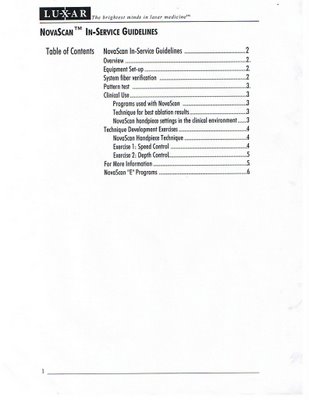


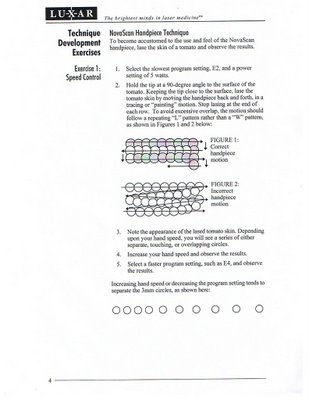

Wednesday, July 12, 2006
Sunday, July 09, 2006
Website writing
I accepted the challenge and met his deadline, although I would not like to do a job this difficult under such a tight deadline again.
Of the five sites, only one remains in publication, "Beyond Legal." The other four were samples for clients. I'm not clear what Seth was using the websites to accomplish. But they no longer exist.
Here is a sample from "Beyond Legal," addressing the challenges of being sued.
The Unthinkable: Being Sued
From www.beyondlegal.com
Written by Diane De Rooij, June 2004.
There are few moments in life where the stomach sinks so deeply as the moment you are served with a summons to appear in court and defend yourself against a lawsuit. In your shock and horror, you may not want to admit or consider that you need a lawyer. But make no mistake. No amount of righteous rightness can substitute for a savvy attorney. Even if you are innocent, you may end up losing everything you own. If you are not innocent, you need an attorney even more, to advocate for you and seek a fair settlement.
When summoned, you have a limited time to answer. Use this time to find the right attorney. If you need more time, you may contact the court clerk and ask for the forms you need to ask for an extension. In the meantime, start checking your insurance policies. If there is a possibility your property will be seized if you lose, sometimes homeowners insurance will pay for a portion of your legal representation.
From the moment you are served until the day you appear in court, speak to NO ONE about the issues contained in the lawsuit. Anyone you talk to can be called to court to testify against you. Furthermore, discussing conversations and documents that go between you and your attorney can vitiate the privilege, which is essential in any legal action.
Once you have an attorney, work toward a resolution quickly. Look into settlement, mediation, arbitration and dismissal. All these options will cost you money, but can’t compare to your financial exposure if you lose in court.
If you go the distance, a judge or jury will determine liability—for the defendant and/or the plaintiff. As a defendant, the decision may be that you are not liable or responsible. Or the judgment may be split between you and the plaintiff, if the judge or jury determine each of you shares a percentage of the liability.
Tell your attorney everything, and tell him or her the truth. Don’t leave anything out or start shredding documents to protect yourself. This is a perfect way to let your attorney get sandbagged in court and for you to lose it all. And even if you are innocent and outraged at the insult of being sued, stay calm and reasonable. Don’t taunt your opponent. Don’t act cocky. Don’t appear bitter.
When judges try to determine who is being truthful and who is lying, they look for an appearance of guilt—shifty eyes, shaky voice, angry face. If you believe the truth will set you free, be calm, cool, collected and civil. Make eye contact with the judge and jury, as well as with your opponent.
Remember, even though it seems like the end of the world to you, your plight means very little to the members of the court who will hear your case. Try to keep everything in perspective and with out drama. Be brief and respectful.
Make sure you turn to your attorney for advice if there are any elements of the case that make you feel uncertain. Let your attorney protect you. Detach from the fear and have confidence. You will have your day in court soon enough.
Tuesday, July 04, 2006
Monday, July 03, 2006
Working hard for her own pleasure
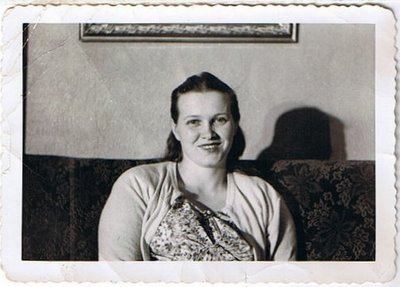
SHE BENDS OVER THE UTILITY SINK, her galvanized bucket receiving a stream of scalding hot water, and pours granules of Spic-N-Span through the clouds of steam.
On this average 1950s Saturday night, in her small town, she sets up her tools, preparing for the task ahead.
Like all the other farmwives, she has lived through a week of dirty boots tracking mud across her floors, spilled milk, and wrestling children. The black-and-white checkerboard of the kitchen floor is covered with the evidence.
Like all the other farmwives, Sunday is her day. In the morning she will put on her seamed stockings and her best dress, and she will go to church.
After the service is over, after the men have stood in circles and smoked outside, after the weather has been discussed and diseases of cattle reviewed, she will go back to her house. Someone will come by—the minister, some in-laws, someone she sees only on Sunday at church—and she will serve them coffee, and the cake she made for Sunday.
But before her company arrives, she will put her house in order. No matter how tired she is, no matter how much work she has done, on Sunday morning her kitchen floor will be clean.
So on Saturday night, after all the children are bathed, their hair wound into pincurls, their tiny Sunday clothes ironed and hung up for tomorrow, she mops the floor.
And in all the other farms for miles around, lights glow from kitchen windows, making silhouettes of farmwives, mothers all, dedicated workers with reddened hands, purposefully stroking ragmops across old linoleum, bending over steaming buckets, their last task before sleep and a Sunday of rest.
IF SHE WANTED TO, MY MOTHER COULD STILL MOP A MEAN FLOOR. In a few days, she will be 73 years old, but her years at hard labor on the farm have only made her strong.
Now she has a no-wax floor, but it still needs tending, and she still frets after a week of grandkids, a mud-footed husband and good old Wenatchee clay have left their marks.
I keep this image of my mother because she still mops the floor, and she does it with the same pride and craftsmanship she demonstrated on the old farmhouse linoleum.
It’s not so much that I want to be a good farmwife and mother or match my mother’s energy level. And I confess: I do not mop my kitchen floor once a week.
In a sense, I learned more about meeting goals and getting things done from watching my mother on Saturday night than I ever learned after we left the farm.
That floor had to be mopped, not to teach her daughter a lesson about work, or even to make a favorable impression on the neighbors. It had to be mopped so my mother could have time to herself, to create a pure spot of joy in her hard life.
When she woke up a few hours later she could indulge in a moment of pride, standing in the kitchen doorway and seeing the pristine white squares against the shiny black ones. She had done a hard job well for her own pleasure.
WHEN I MOP MY FLOOR, IT’S NO ACCIDENT THAT I DO IT ON SATURDAY NIGHT, with all the lights off in the house but the one in the kitchen. And while I stroke my modern sponge mop across the black-and-white squares of my no-wax vinyl, I fall into a trance made of love and reverence for my mother.
I HAVE WRITTEN THIS STORY IN MY HEAD on every Saturday night that I mopped my own floor, trying to imagine how it felt to be a woman with eight children, living on a farm in the 1950s.
Like any good daughter, I feel shy but intrigued when I try to stand in my mother’s shoes. But I do know how she felt, because she still feels that way today.
When I go to visit after she’s cleaned the kitchen, she says, “Look at my floor! Isn’t it clean?” After all these years, it still brings her joy.
She taught me how to mop a floor, but that’s not all I learned. My mother taught me how to do a hard job well for my own pleasure.
Looking for Jack
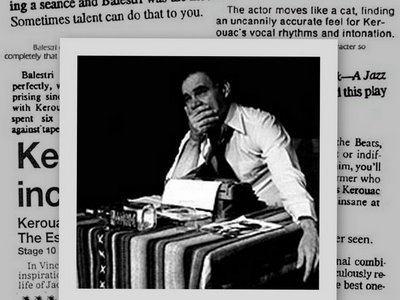
A jazz play by Vincent Balestri
Velvet Elvis Arts Lounge Theater
107 Occidental, Seattle, 206/624-8477
Playing now through February 1997 Saturday, July 01, 2006
Fine and Commercial Art
Using graphics programs at every generation, I learned to use the capabilities of each one to create the best possible graphic for the technology of the day. As such I worked with small magazines, newspapers and subsidy presses, creating designs, advertisements, layouts, photographs, drawings and other elements of publishing.
A few of those items appear below. ^A simple floor plan for a proposed office space merger of two publishing concerns.
^A simple floor plan for a proposed office space merger of two publishing concerns. ^A simple line drawing advertisement commissioned to the real estate client's specifications.
^A simple line drawing advertisement commissioned to the real estate client's specifications. ^The second line drawing used in a consecutive ad, again at the client's request.
^The second line drawing used in a consecutive ad, again at the client's request. ^A snowy egret: graphite on paper
^A snowy egret: graphite on paper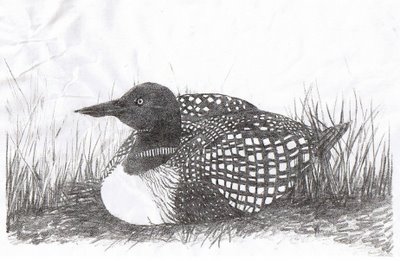 ^Loon, graphite on paper.
^Loon, graphite on paper. ^Story art, HOME Magazine, Bellevue Journal American newspaper
^Story art, HOME Magazine, Bellevue Journal American newspaper ^Detail from "Virgin of the Rocks," Leonardo da Vinci, graphite on Coquille board
^Detail from "Virgin of the Rocks," Leonardo da Vinci, graphite on Coquille board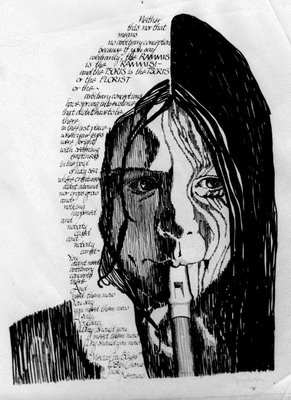 ^Mixed art project, calligraphy and water color pens
^Mixed art project, calligraphy and water color pens
Thursday, June 01, 2006
Friday, May 12, 2006
Friday, May 05, 2006
Beat Generation webpage tributes
The pages follow a collage concept and include iconic images relevant to the personalities they depict. They are designed as introductory vehicles for students of American literature.
Clicking on each image will launch a larger version of the page or design.
Allen Ginsberg

Jack Kerouac

William S. Burroughs
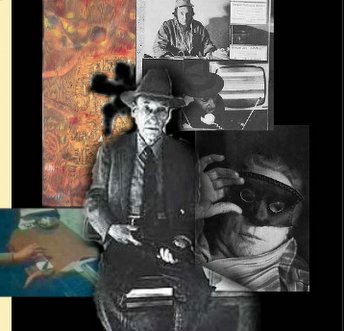
Draft of another William S. Burroughs graphic test, for future reference.



